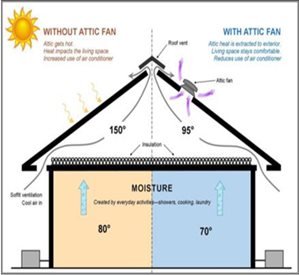Attic ventilation
In previous press releases it has been announced that I have chosen International Solar Solutions as the ideal partner for us in the area of attic management. Yes, I said management. If you are not managing your attic, it is managing you!
As I have mentioned before, I have been in many, many attics over the years. It is the one area of a single dwelling house that I feel is most neglected. An attic serves a number of purposes. It is the final barrier in the home (after Equality windows and proper R Value insulation in the walls), that controls air tightness in the living space. Just think of the attic as the weakest link in the control of air temperature in the home. Doesn’t it make sense then that an attic has the same level of airtightness and be temperature controlled just as the rest of the home is?
Poorly Ventilated Attic Spaces are Especially Affected by Weather Conditions.
Roof shingles curl up and lose their ability to seal. The roof shingles, wooden trusses and under-structure of an attic suffer from long periods of neglect from exposure to too much heat and humidity, and cause homes to leak air that you have paid money to heat or cool. Roof shingles will deteriorate faster. Too much humidity in the living space over time will also damage wall studs and warp drywall and hardwood flooring. These are the two most common results of an overheated, over humidified attic.
Cause and Reaction
We all know that hot air expands and is always looking to travel or escape its confines. In the spring, summer and fall, attic air temperatures can reach 160°F versus the 68° – 73° desired temperature in the living space. The air cannot escape the attic space sufficiently or with any regularity. The hot air is stratified and acts as a heat-trap barrier in the home, causing the living space to endure higher than necessary temperatures and humidity levels. What do we do then? We crank up the air-conditioner of course!
We control the humidity in our home by way of adjusting temperature and airflow. Cooling down the house in the summer also reduces humidity. Humidifiers on furnaces provide the right amount of moisture in the home during winter. The number one reason we control humidity this way is our desire to be comfortable, but there are other benefits. How often do you like getting your roof replaced?
Optimal Attic Ventilation is the Goal
Just like windows and walls, the attic space should be adequately insulated (as air-tight as possible), but equally important is ongoing controlled ventilation. It should be noted that the number one overall home energy conservation recommendation from the US Department of Energy is focused on optimal attic air-tightness.
Natural Resources Canada, the Canadian federal agency that addresses energy efficiency standards, suggests that for any home that may be subject to high heat gains or heat losses, the cause is most likely an attic without sufficient insulation and poor ventilation control. In Canada the National R-2000 housing program advises that these two principles (insulation and ventilation control), coupled together will create a most favourably conditioned air-tight home which will ensure the durability of the roof and building structure, and provide maximum occupant comfort in all seasons.
The best solution is to ensure the attic has adequate controlled ventilation.
Temperature Synchronization Has Its Rewards
The ideal objective is to always have the attic temperature closely resemble the outside air temperature. If the two environment’s temperatures are closely tied together, the air in the attic will no longer be over heated and pressurized. This is an ideal condition to extend the lifespan of roofing shingles and attic structure and experience the desired home comfort without spending a fortune on heating and air-conditioning costs…or worse premature roof replacement!
The Ideal Solution
My recommendation to our followers is an attic fan, a Solar Attic Fan from the people at International Solar Solutions to be more specific.
